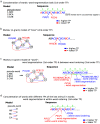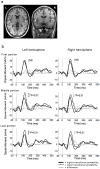Neurophysiological Markers of Statistical Learning in Music and Language: Hierarchy, Entropy, and Uncertainty
- PMID: 29921829
- PMCID: PMC6025354
- DOI: 10.3390/brainsci8060114
Neurophysiological Markers of Statistical Learning in Music and Language: Hierarchy, Entropy, and Uncertainty
Abstract
Statistical learning (SL) is a method of learning based on the transitional probabilities embedded in sequential phenomena such as music and language. It has been considered an implicit and domain-general mechanism that is innate in the human brain and that functions independently of intention to learn and awareness of what has been learned. SL is an interdisciplinary notion that incorporates information technology, artificial intelligence, musicology, and linguistics, as well as psychology and neuroscience. A body of recent study has suggested that SL can be reflected in neurophysiological responses based on the framework of information theory. This paper reviews a range of work on SL in adults and children that suggests overlapping and independent neural correlations in music and language, and that indicates disability of SL. Furthermore, this article discusses the relationships between the order of transitional probabilities (TPs) (i.e., hierarchy of local statistics) and entropy (i.e., global statistics) regarding SL strategies in human's brains; claims importance of information-theoretical approaches to understand domain-general, higher-order, and global SL covering both real-world music and language; and proposes promising approaches for the application of therapy and pedagogy from various perspectives of psychology, neuroscience, computational studies, musicology, and linguistics.
Keywords: Markov model; domain generality; entropy; implicit learning; information theory; n-gram; order; statistical learning; uncertainty; word segmentation.
Conflict of interest statement
The author declares no conflicts of interest.
Figures




Similar articles
-
Entropy, Uncertainty, and the Depth of Implicit Knowledge on Musical Creativity: Computational Study of Improvisation in Melody and Rhythm.Front Comput Neurosci. 2018 Dec 19;12:97. doi: 10.3389/fncom.2018.00097. eCollection 2018. Front Comput Neurosci. 2018. PMID: 30618691 Free PMC article.
-
Musical expertise facilitates statistical learning of rhythm and the perceptive uncertainty: A cross-cultural study.Neuropsychologia. 2020 Sep;146:107553. doi: 10.1016/j.neuropsychologia.2020.107553. Epub 2020 Jul 8. Neuropsychologia. 2020. PMID: 32649945
-
Depth and the Uncertainty of Statistical Knowledge on Musical Creativity Fluctuate Over a Composer's Lifetime.Front Comput Neurosci. 2019 Apr 30;13:27. doi: 10.3389/fncom.2019.00027. eCollection 2019. Front Comput Neurosci. 2019. PMID: 31114493 Free PMC article.
-
Statistical Learning and Language Impairments: Toward More Precise Theoretical Accounts.Perspect Psychol Sci. 2021 Mar;16(2):319-337. doi: 10.1177/1745691620953082. Epub 2020 Nov 2. Perspect Psychol Sci. 2021. PMID: 33136519 Free PMC article. Review.
-
Neurocognitive mechanisms of statistical-sequential learning: what do event-related potentials tell us?Front Hum Neurosci. 2014 Jun 18;8:437. doi: 10.3389/fnhum.2014.00437. eCollection 2014. Front Hum Neurosci. 2014. PMID: 24994975 Free PMC article. Review.
Cited by
-
Neurophysiological and functional neuroanatomical coding of statistical and deterministic rule information during sequence learning.Hum Brain Mapp. 2021 Jul;42(10):3182-3201. doi: 10.1002/hbm.25427. Epub 2021 Apr 2. Hum Brain Mapp. 2021. PMID: 33797825 Free PMC article.
-
Unpredictability of the "when" influences prediction error processing of the "what" and "where".PLoS One. 2022 Feb 3;17(2):e0263373. doi: 10.1371/journal.pone.0263373. eCollection 2022. PLoS One. 2022. PMID: 35113946 Free PMC article.
-
Linking the neural basis of distributional statistical learning with transitional statistical learning: The paradox of attention.Neuropsychologia. 2022 Jul 29;172:108284. doi: 10.1016/j.neuropsychologia.2022.108284. Epub 2022 Jun 3. Neuropsychologia. 2022. PMID: 35667495 Free PMC article.
-
Seeking the neural representation of statistical properties in print during implicit processing of visual words.NPJ Sci Learn. 2023 Dec 16;8(1):60. doi: 10.1038/s41539-023-00209-3. NPJ Sci Learn. 2023. PMID: 38102191 Free PMC article.
-
Advances in the Neurocognition of Music and Language.Brain Sci. 2020 Aug 2;10(8):509. doi: 10.3390/brainsci10080509. Brain Sci. 2020. PMID: 32748810 Free PMC article.
References
-
- Chomsky N. Syntactic Structures. Mouton; The Hague, The Netherlands: 1957.
-
- Lerdahl F., Jackendoff R. A Generative Theory of Tonal Music. MIT Press; Cambridge, MA, USA: 1983.
Publication types
LinkOut - more resources
Full Text Sources
Other Literature Sources

